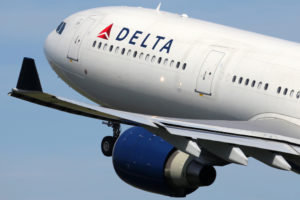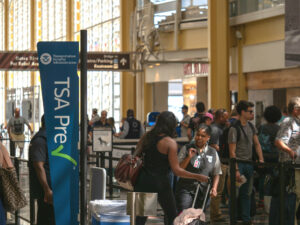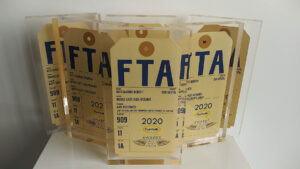Dynamic Currency Conversion (DCC)
#1
Original Poster
Join Date: Jul 2009
Location: SJC
Programs: AA, AS, Marriott
Posts: 6,192
I returned from Italy and didn't see DCC a single time in Rome, Florence, and Pisa. I did do a lot of contactless payments, which might have helped prevent it. However, a few of the usual suspects for DCC (duty free, airport hotel, and restaurants in tourist areas) didn't result in any DCC. It was likely an option at both of my hotels in Rome and Florence, but I didn't see it since I had used an AmEx to pay.
Both the Harrods and F&M shops at LHR T5 are still doing DCC, and I saw multiple people opting in. At least at Harrods the cashiers were asking for currency preference. When I said pound sterling the cashier actually reached over the counter and in a nanosecond had pressed cancel to opt out of DCC.
Both the Harrods and F&M shops at LHR T5 are still doing DCC, and I saw multiple people opting in. At least at Harrods the cashiers were asking for currency preference. When I said pound sterling the cashier actually reached over the counter and in a nanosecond had pressed cancel to opt out of DCC.
#2
Moderator: Lufthansa Miles & More, India based airlines, India, External Miles & Points Resources
Join Date: Dec 2002
Location: MUC
Programs: LH SEN
Posts: 48,744
Last week in Sweden I saw DCC on most terminals. The SEK option was greyed out and on the left, the EUR in bright green on the right. It took a while for me to find the right spot to press to stay in local currency 
My wife also asked me what this SEK/EUR thing was after she came back from shopping alone. She knew not to accept the EUR option and struggled to push the right buttons. It seems she did ask the cashiers who all insisted the end result was the same and that she should just accept EUR. She didn't though. ^
She didn't though. ^

My wife also asked me what this SEK/EUR thing was after she came back from shopping alone. She knew not to accept the EUR option and struggled to push the right buttons. It seems she did ask the cashiers who all insisted the end result was the same and that she should just accept EUR.
 She didn't though. ^
She didn't though. ^
#3
Original Poster
Join Date: Jul 2009
Location: SJC
Programs: AA, AS, Marriott
Posts: 6,192
Last week in Sweden I saw DCC on most terminals. The SEK option was greyed out and on the left, the EUR in bright green on the right. It took a while for me to find the right spot to press to stay in local currency 
My wife also asked me what this SEK/EUR thing was after she came back from shopping alone. She knew not to accept the EUR option and struggled to push the right buttons. It seems she did ask the cashiers who all insisted the end result was the same and that she should just accept EUR. She didn't though. ^
She didn't though. ^

My wife also asked me what this SEK/EUR thing was after she came back from shopping alone. She knew not to accept the EUR option and struggled to push the right buttons. It seems she did ask the cashiers who all insisted the end result was the same and that she should just accept EUR.
 She didn't though. ^
She didn't though. ^As a side story, I found someone respond quickly, "Euro!" when offered at Harrods yesterday at LHR T5. In the customer's defense, if most of the customer's shopping is within the euro area then the person might be ignorant of DCC just like if you're coming from a larger country such as the US, Canada, the UK, Australia, or Japan. I tend to think people from places like Hong Kong are more likely to have encountered DCC in the past and respond appropriately. Pretty much everyone I talk to who's a seasoned international traveler knows about the DCC scam, but the occasional traveler does not. As I've said before, I've even have had a few people mention, "Yeah. It was great. I could pay in dollars!"

I am also completely shocked at the number of people still bringing cash and going to bureaux de change or even at the hotels. In fact, at one of my hotels the reception clearly stated, "I would recommend using a cash machine if it's an option as the exchange rate is better." They weren't small sums of money either! I simply don't understand why people don't withdraw currency on arrival, especially since there are options - at least stateside - of doing so without fees and a 0% foreign transaction fee.
#4
Moderator: Lufthansa Miles & More, India based airlines, India, External Miles & Points Resources
Join Date: Dec 2002
Location: MUC
Programs: LH SEN
Posts: 48,744
You had a field on the left with SEK with a dark grey box backgound (black text on dark grey) and the same sized box with a green background (black on green). Touching the dark grey box with the fingernail did the trick. The color scheme suggested EUR/DCC to be better. All customer facing.
#5
Original Poster
Join Date: Jul 2009
Location: SJC
Programs: AA, AS, Marriott
Posts: 6,192
You had a field on the left with SEK with a dark grey box backgound (black text on dark grey) and the same sized box with a green background (black on green). Touching the dark grey box with the fingernail did the trick. The color scheme suggested EUR/DCC to be better. All customer facing.


(Forever 21 and Kate Spade)
It's all configured to get people to select DCC without thinking but still being compliant enough for allowing those in the know to opt out.
#6
Join Date: Feb 2014
Posts: 5
It was the Sklep Freshmarket...on one of the roads surrounding the main square. However, you forced me to get the receipt out and look at it. Guess what, even after the cashier offered Zlotys because it was less expensive for me, the actual transaction occurred in dollars. Another to dispute with Chase!
#7
Join Date: Nov 2012
Posts: 3,537
With my chip&pin VISA I observed that card terminals with additional customer PIN pad offer the DCC option to the cashier after entering the PIN even though the PIN pad displays the amount in PLN only. In Poland be suspicious with English text on the PIN pad display, e.g. AMOUNT PLN 150 ENTER PIN and check carefully what the cashier is doing on his terminal after the PIN has been entered.
#8
Original Poster
Join Date: Jul 2009
Location: SJC
Programs: AA, AS, Marriott
Posts: 6,192
With my chip&pin VISA I observed that card terminals with additional customer PIN pad offer the DCC option to the cashier after entering the PIN even though the PIN pad displays the amount in PLN only. In Poland be suspicious with English text on the PIN pad display, e.g. AMOUNT PLN 150 ENTER PIN and check carefully what the cashier is doing on his terminal after the PIN has been entered.
#9
Join Date: Feb 2005
Location: CGN
Programs: KL FlyingBlue Gold, AY+, MM FTL, TK*G
Posts: 348
Last week in Sweden I saw DCC on most terminals. The SEK option was greyed out and on the left, the EUR in bright green on the right. It took a while for me to find the right spot to press to stay in local currency 
My wife also asked me what this SEK/EUR thing was after she came back from shopping alone. She knew not to accept the EUR option and struggled to push the right buttons. It seems she did ask the cashiers who all insisted the end result was the same and that she should just accept EUR. She didn't though. ^
She didn't though. ^

My wife also asked me what this SEK/EUR thing was after she came back from shopping alone. She knew not to accept the EUR option and struggled to push the right buttons. It seems she did ask the cashiers who all insisted the end result was the same and that she should just accept EUR.
 She didn't though. ^
She didn't though. ^
#10
Join Date: Oct 2013
Posts: 353
PayPal and Ebay have now stopped to worry about DCC (see https://www.paypal-community.com/t5/.../920926/page/8 ) . They are now charging people in their home currency without asking. 

#11
FlyerTalk Evangelist
Join Date: Jul 2003
Location: Florida
Posts: 29,880
Do you mean that they don't offer DCC? That would make sense for an establishment that had few non-local customers. I'm sure that the banks run reports on current merchant accounts to identify which have the biggest opportunity to try to sell DCC to. Why bother with those where there's little potential for extra profit.
More than one eateries actually told me, "we dont take Union Pay. It must be HKD." That is what I got from a local chain of mid-range banquet restaurants that is famous for their bargain period for breakfast that often has some really good dim sum combo at like 50% off. (稻香 - the Wanchai location above the Lee Garden is very good, not so much at other locations).
Even the very touristy Crystal Jade (翡翠拉麵小籠包) at IFC did not attempt DCC. They do have an attitude to mainlanders though as they mistook us being from mainland when assigning table. Had to talk to a manager to get things sorted. However, definitely not offered DCC option, nor automatically DCC our US-issued card.
Not a single one attempted to DCC.
When I reiterated to the waitress / waiter when handing them my US-issued card I always asked them to bill in HKD. My brother told me not to worry more than one time that the restaurants will bill in HKD. We quite like the Cantonese banquet restaurant atop the Tin Hau MTR station. This restaurant is what I would term "Restaurant for the community" - it fills up around 7:30 every night with guests you know are from nearby. During the Mother's Day / Father's Day, Chinese Festivals, etc, the restaurant is full of extended families having a feast even though the prices generally go up 40% from normal days and all the "specials" were not offered. I was even scolded once by the older waitress when I asked to make sure it was billed in HKD - the 阿嬸 gave me a look, said LOUDLY, " If it is not HKD, what do you think?!" "WE DONT TAKE UNION PAY!"
I am just trying to tell you people, the eateries we go to, are VERY MUCH DIFFERENT from the restaurants you go to. Different preferences on the foods, and of course we dont much care for "atmosphere" - we only care for good foods at reasonable prices.
So there. It all depends on WHERE you go. Then in some places how you look and what language you speak, probably make a difference as well.
You can believe it or not I could not care less. We visited HKG 4 times in 2016, ate at enough restaurants whether only ourselves or with families, my US-issued CCs NEVER experience DCC. The only places are hotels where you do need to assert your choice and make sure they comply. They do comply even though the procedures often are not transparent and quite confusing.
Will report back on the upcoming trip during CNY period if I remember to drop by this thread after trip.
Now I would need to pay attention in Abu Dhabi and Dubai! Hardly any data on this thread or I have missed it.
Last edited by Happy; Jan 7, 2017 at 10:43 am
#13
Original Poster
Join Date: Jul 2009
Location: SJC
Programs: AA, AS, Marriott
Posts: 6,192
I definitely expect it at duty free shops, hotels, rental cars, department stores, and restaurants catering to a foreign clientele, but DCC is not exclusive to these usual suspects.
#14
Moderator: Lufthansa Miles & More, India based airlines, India, External Miles & Points Resources
Join Date: Dec 2002
Location: MUC
Programs: LH SEN
Posts: 48,744
We got this circular at work asking to avoid DCC 

Liebe Reisende, in letzter Zeit wurde Mitarbeitern bei der Bezahlung ihrer Hotelrechnung vermehrt angeboten, diese nicht in Landeswährung (Local Currency) sondern in Euro zu fakturieren.
Daraufhin legte das Hotel oft einen willkürlichen, meist für das Unternehmen sehr ungünstigen Wechselkurs zugrunde...
Daraufhin legte das Hotel oft einen willkürlichen, meist für das Unternehmen sehr ungünstigen Wechselkurs zugrunde...
#15
Join Date: Oct 2007
Programs: AA, WN, UA, Bonvoy, Hertz
Posts: 2,509
Just an update that during a trip to Australia, only twice during the entire trip was DCC even prompted. Both retailers that asked had the same type of strange standalone terminal where you put the chip card in vertically whereas everyone else had a horizontal insert machine of varying types. I am sure it is a specific processor doing such evil deeds. The worse part is one of them was the SYD duty free. I was asked about DCC in these two cases, so I could pick AUD, but also to note those were the only two merchants who had normal casing on my Capital One statement as well (upper and lower) while every other charge uses the all caps (which is common for 90% of my US charges too).
Now AUS has other quirks like the allowance of merchants to charge a service fee (which I saw come up a number of times), and they are tap for *everything* including their stored value transit cards, amusement park tickets, hotels, passport e-gates, but I didn't have a good non-FTF tap card to use sadly. I only saw *one* unattended kiosk the entire trip that only took tap (it was a vending machine in the airport bathroom). All other kiosks took at least chip as well.
Because I was a good person and used a MC card, I was asked if they could Paypass (tap) my card. Obviously, nothing happened so they had to insert. I had a PIN card if needed, but signature card worked everywhere.
Rasheed
Now AUS has other quirks like the allowance of merchants to charge a service fee (which I saw come up a number of times), and they are tap for *everything* including their stored value transit cards, amusement park tickets, hotels, passport e-gates, but I didn't have a good non-FTF tap card to use sadly. I only saw *one* unattended kiosk the entire trip that only took tap (it was a vending machine in the airport bathroom). All other kiosks took at least chip as well.
Because I was a good person and used a MC card, I was asked if they could Paypass (tap) my card. Obviously, nothing happened so they had to insert. I had a PIN card if needed, but signature card worked everywhere.
Rasheed





















